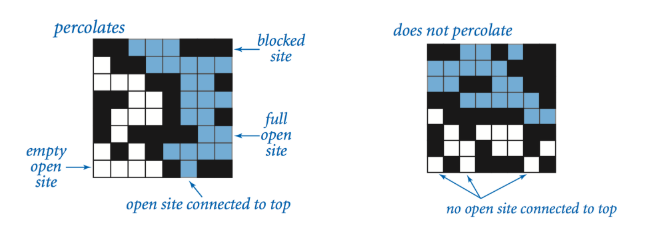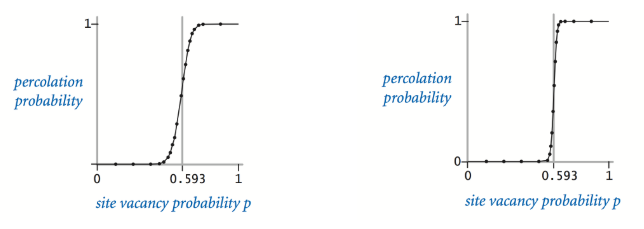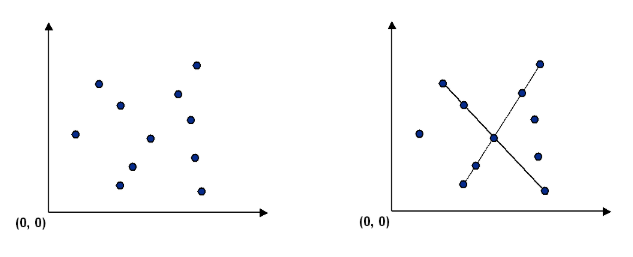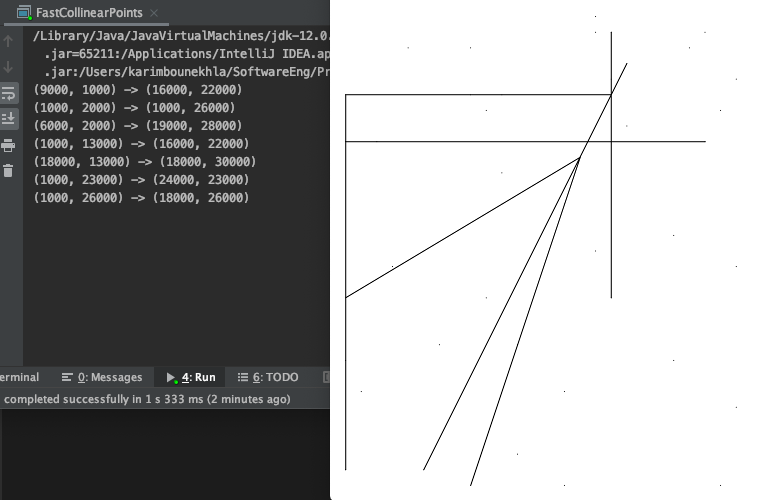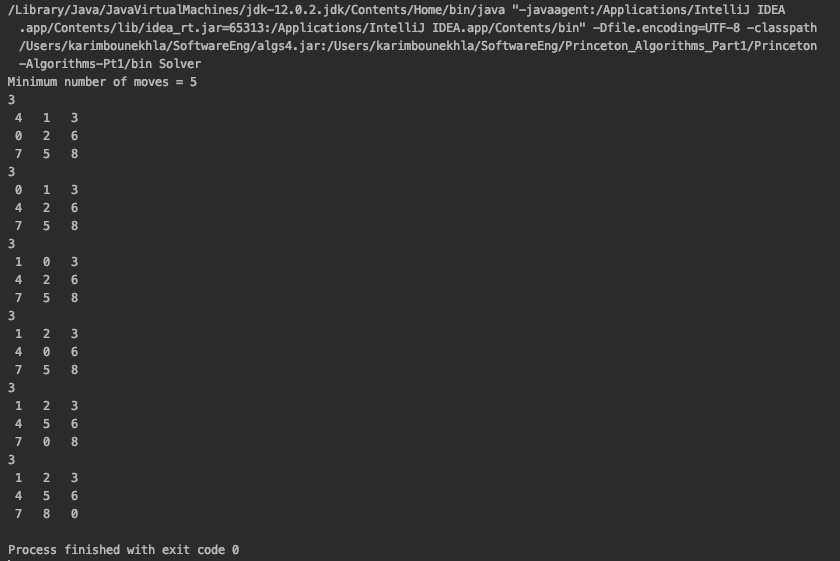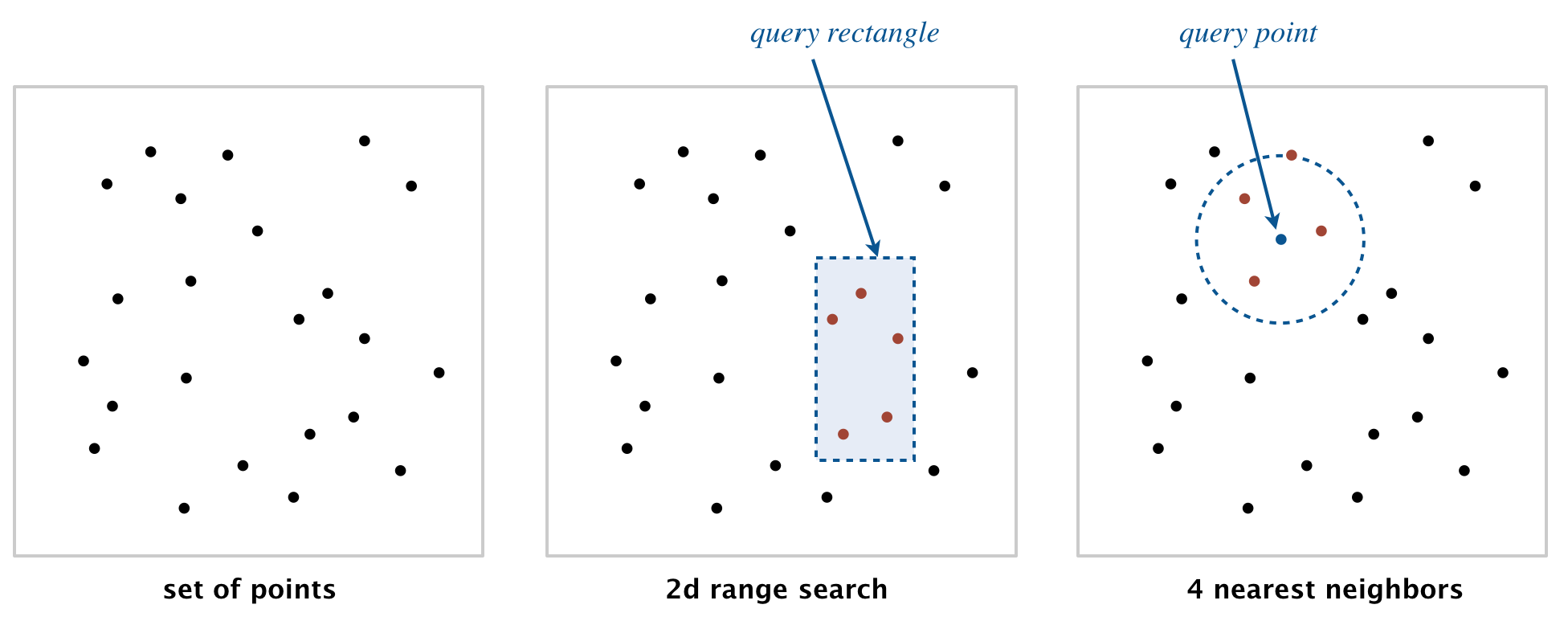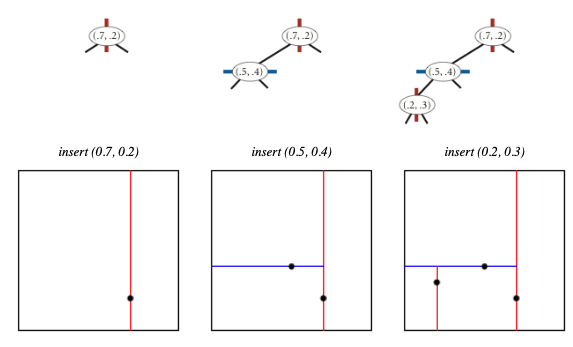Introduction to Algorithms, created by Princeton University.
This course covers algorithms and data structures, with emphasis on applications and performance analysis of Java implementations.
Part I covers elementary data structures, sorting, and searching algorithms. Part II focuses on graph- and string-processing algorithms.
This repo contains my work in progress for Part 1 of the course - Part 2 coming soon.
This assignment explores the concept of percolation using a model composed of an n-by-n grid of sites. Each site being either open or blocked. A full site is an open site that can be connected to an open site in the top row. A system is said to percolate if there is a full site in the bottom row - i.e. it is connected to the top row.
(From the problem statement)
Given a composite systems comprised of randomly distributed insulating and metallic materials: what fraction of the materials need to be metallic so that the composite system is an electrical conductor? Given a porous landscape with water on the surface (or oil below), under what conditions will the water be able to drain through to the bottom (or the oil to gush through to the surface)? Scientists have defined an abstract process known as percolation to model such situations.
The objective of this problem set was to determine the probability that a system will percolate if sites are independent and set to open with probability p. When p equals 0, the system does not percolate, and when p equals 1, the system percolates (all sites are open). When n is sufficiently large, there is a threshold probability p* at which the system will tend to percolate (around 0.593).
In this program, I modelled the Percolation system (n-by-n grid) and ran a Monte Carlo simulation to estimate the percolation threshold using the Union-find algorithm.
Results were consistent with the experimentally observed percolation threshold.
The goal of this assignment was to program a deque (double-ended queue) and a randomized queue implementing the following API's (respectively):
public class Deque<Item> implements Iterable<Item> {
// construct an empty deque
public Deque()
// is the deque empty?
public boolean isEmpty()
// return the number of items on the deque
public int size()
// add the item to the front
public void addFirst(Item item)
// add the item to the back
public void addLast(Item item)
// remove and return the item from the front
public Item removeFirst()
// remove and return the item from the back
public Item removeLast()
// return an iterator over items in order from front to back
public Iterator<Item> iterator()
// unit testing (required)
public static void main(String[] args)
}
public class RandomizedQueue<Item> implements Iterable<Item> {
// construct an empty randomized queue
public RandomizedQueue()
// is the randomized queue empty?
public boolean isEmpty()
// return the number of items on the randomized queue
public int size()
// add the item
public void enqueue(Item item)
// remove and return a random item
public Item dequeue()
// return a random item (but do not remove it)
public Item sample()
// return an independent iterator over items in random order
public Iterator<Item> iterator()
// unit testing (required)
public static void main(String[] args)
}
Given a set of n distict points, the goal of this assignment is to find every (maximal) line segments that connects a subset of 4 or more of the points
Two methods were implemented, first a Brute-force method that examines 4 points at a time and check whether they all lie on the same line segment (if the slopes between the points are all equal). The running time of this method is N^4 and is not practical.
The second method implements fast sorting algorithm to find collinear points in N^2*log(N) time.
Think of p as the origin.
For each other point q, determine the slope it makes with p.
Sort the points according to the slopes they makes with p.
Check if any 3 (or more) adjacent points in the sorted order have equal slopes with respect to p.
If so, these points, together with p, are collinear.
Given an input of points, such as this.
50
26000 27000
24000 23000
18000 23000
22000 9000
25000 25000
1000 2000
12000 10000
22000 17000
25000 1000
15000 1000
19000 28000
12000 3000
4000 15000
2000 7000
18000 27000
1000 13000
9000 26000
11000 26000
6000 16000
18000 30000
18000 26000
24000 30000
10000 25000
7000 10000
19000 24000
6000 0
26000 15000
1000 23000
23000 29000
15000 7000
15000 19000
17000 31000
6000 2000
17000 16000
1000 26000
11000 19000
25000 0
17000 30000
16000 22000
18000 13000
3000 23000
10000 13000
1000 9000
11000 21000
29000 19000
9000 29000
30000 3000
9000 1000
5000 29000
26000 6000
The result is a list of collinear point (Displayed on the right using a visualizer library provided by the course).
The goal of this assignment is to write a program that solves the 8-puzzle problem using the A* search algorithm.
(From the problem statement)
The 8-puzzle is a sliding puzzle that is played on a 3-by-3 grid with 8 square tiles labeled 1 through 8, plus a blank square. The goal is to rearrange the tiles so that they are in row-major order, using as few moves as possible. You are permitted to slide tiles either horizontally or vertically into the blank square. The following diagram shows a sequence of moves from an initial board (left) to the goal board (right).
This problem was solved with the A* search algorithm and the use of priority queues. The priority function used used is based on the Manhattan distance = the number of moves made so far + the manhattan distance of the board.
After each potential move (based on the neighbors of the blank tile), the algorithm maintains a priority queue of the potential states of the board following that move - and processes the state with the lowest priority (i.e. closer to the optimal solution).
Given the following board (where 0 represents blank space)
4 1 3
0 2 6
7 5 8
The program outputs the result and moves leading to the solution
Write a data type to represent a set of points in the unit square (all points have x- and y-coordinates between 0 and 1) using a 2d-tree to support efficient range search (find all of the points contained in a query rectangle) and nearest-neighbor search (find a closest point to a query point).
This was solved using a 2d-tree implementation; a generalization of a BST to two-dimensional keys, i.e. with points in the nodes, using the x- and y-coordinates of the points as keys in strictly alternating sequence.
The prime advantage of a 2d-tree over a BST is that it supports efficient implementation of range search and nearest-neighbor search. Each node corresponds to an axis-aligned rectangle in the unit square, which encloses all of the points in its subtree. The root corresponds to the unit square; the left and right children of the root corresponds to the two rectangles split by the x-coordinate of the point at the root; and so forth.
